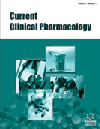- Home
- A-Z Publications
- Current Clinical Pharmacology
- Previous Issues
- Volume 6, Issue 4, 2011
Current Clinical Pharmacology - Volume 6, Issue 4, 2011
Volume 6, Issue 4, 2011
-
-
The Clinical Pharmacology of Short Acting Analgo-Sedatives in Neonates
More LessEffective pain management remains an important indicator of the quality of care provided to neonates, not only from an ethical, but also from a clinical outcome perspective. Significant progresses in non-pharmacological therapies have been made. However - in the meanwhile - neonatal practice also evolved. These shifts in clinical care also induced in a shift in pharmacodynamic end points, and consequently, new pharm Read More
-
-
-
Anacetrapib: A New Weapon Against Dyslipidemia
More LessAnacetrapib is a cholesteryl-ester-transfer-protein (CETP) inhibitor, a new class of experimental drugs in the treatment of primary hypercholesterolemia and dyslipidaemia associated with the metabolic syndrome. One of the major advantages of this agent is, apart from the significant decrease in LDL-C it produces a substantial increase in HDL-C. Phase I, II, and III clinical trials have shown that anacetrapib is Read More
-
-
-
Olfactory Dysfunction and Cognitive Impairment in Age-Related Neurodegeneration: Prevalence Related to Patient Selection, Diagnostic Criteria and Therapeutic Treatment of Aged Clients Receiving Clinical Neurology and Community-Based Care
More LessAuthors: Mark A. Babizhayev, Anatoliy I. Deyev and Yegor E. YegorovA decrease in olfactory function with age has been attributed to a variety of factors including normal anatomical and physiological changes in aging, surgery, trauma, environmental factors, medications and disease. Olfactory impairment has also been associated with neurodegenerative diseases such as Alzheimer's disease (AD) and Parkinson's disease. Deficits in these chemical senses cannot only reduce the pleasure an Read More
-
-
-
Metabolic Correction in the Management of Diabetic Peripheral Neuropathy: Improving Clinical Results Beyond Symptom Control
More LessCurrent Clinical Management Guidelines of Diabetic Peripheral Neuropathy (DPN) are based on adequate glucose control and symptomatic pain relief. However, meticulous glycemic control could delay the onset or slow the progression of diabetic neuropathy in patients with DM type 2, but it does not completely prevent the progression of the disease. Complications of DPN as it continues its natural course, produce increasing Read More
-
-
-
Unexpected High Levels of Vorinostat when Combined with Vinorelbine in Patients with Advanced Cancer
More LessBackground: This study was a multi-centre, dose-escalation trial in patients with advanced cancers. Primary objective was to determine maximum tolerated dose (MTD) of vorinostat, a competitive inhibitor of histone deacetylase (HDAC), in combination with vinorelbine. Secondary aims were to determine (1) corresponding pharmacokinetics, (2) safety of this regimen, and (3) impact of UGT1A1 and 2B17 polymorphisms on vorin Read More
-
-
-
Clonidine: Clinical Pharmacology and Therapeutic Use in Pain Management
More LessPain is an unpleasant sensory perception warning of actual or impending tissue damage. Pain serves a vital physiological role, however, severe and uncontrolled pain in the peri-operative setting can adversely affect outcome from surgery and lead to chronic pain. Multiple neurochemical and receptor processes are involved in pain perception but the role of pro-inflammatory cytokines and adrenergic pathways has only recentl Read More
-
-
-
Supplementation of Glutamine and Omega-3 Polyunsaturated Fatty Acids as a Novel Therapeutic Intervention Targeting Metabolic Dysfunction and Exercise Intolerance in Patients with Heart Failure
More LessAuthors: Khurram Shahzad, Aalap Chokshi and P. Christian SchulzeWith its increasing prevalence throughout the world, heart failure continues to be associated with high morbidity and mortality. Patients with heart failure develop progressive metabolic abnormalities, inflammation, and atrophy in the myocardium and skeletal muscle. Improvement in functional capacity as defined by exercise tolerance is essential for better quality of life and potentially survival of these patients. Therapeutic man Read More
-
-
-
Drug-Induced Anemia and Other Red Cell Disorders: A Guide in the Age of Polypharmacy
More LessAuthors: Aryeh Shander, Mazyar Javidroozi and E. AshtonSeveral medications have been linked to red blood cell (RBC) disorders. The frequency of these side effects varies, depending on the condition, but they can be associated with significant morbidity and mortality. The problem is likely to exacerbate in aging populations with frequent comorbidities, proportional to the growing number of medications used. Notable drug-related RBC disorders include hemolytic anemia, megaloblastic a Read More
-
-
-
Antibiotic Resistance of Bacterial Strains Isolated from Patients with Community-Acquired Urinary Tract Infections: An Exploratory Study in Palestine
More LessAuthors: Adham S. Abu Taha and Waleed M. SweilehBackground and Objectives: No studies about resistance of bacteria isolated from patients with communityacquired urinary tract infections (CA-UTI) or local guidelines for antibiotic use in these infections have been published or established in the West Bank, Palestine. The objectives of this study were to determine the (1) type and frequency of isolated bacteria and (2) their resistance to commonly used antibiotics. Methods: A cro Read More
-
Volumes & issues
Most Read This Month
Article
content/journals/ccp
Journal
10
5
false
en


